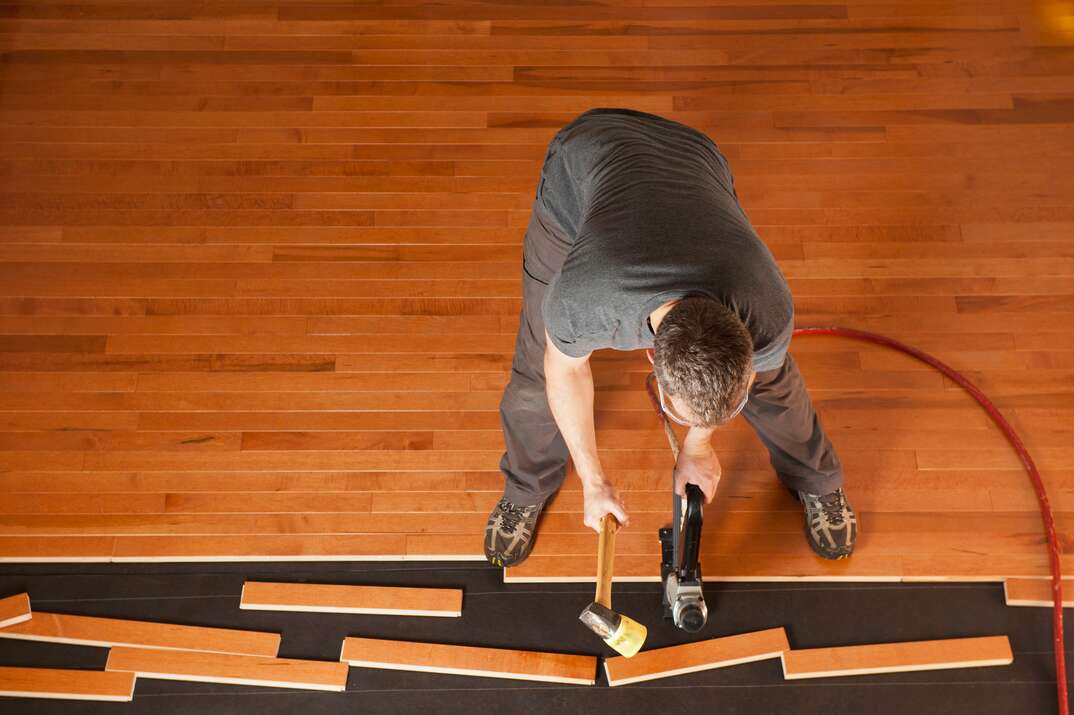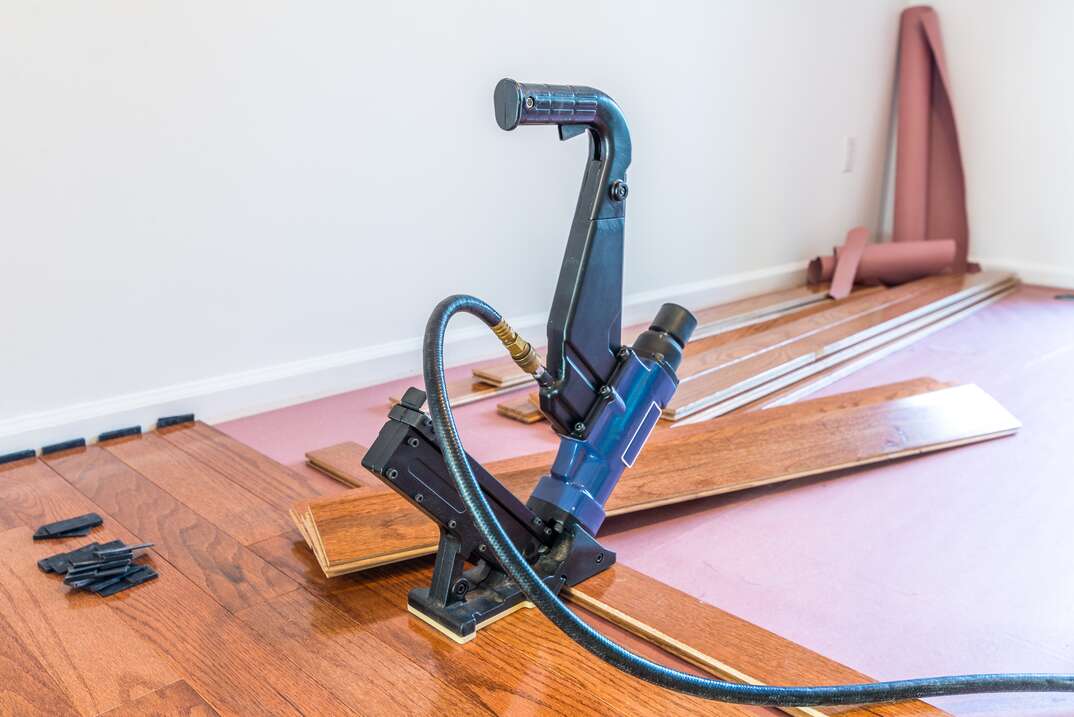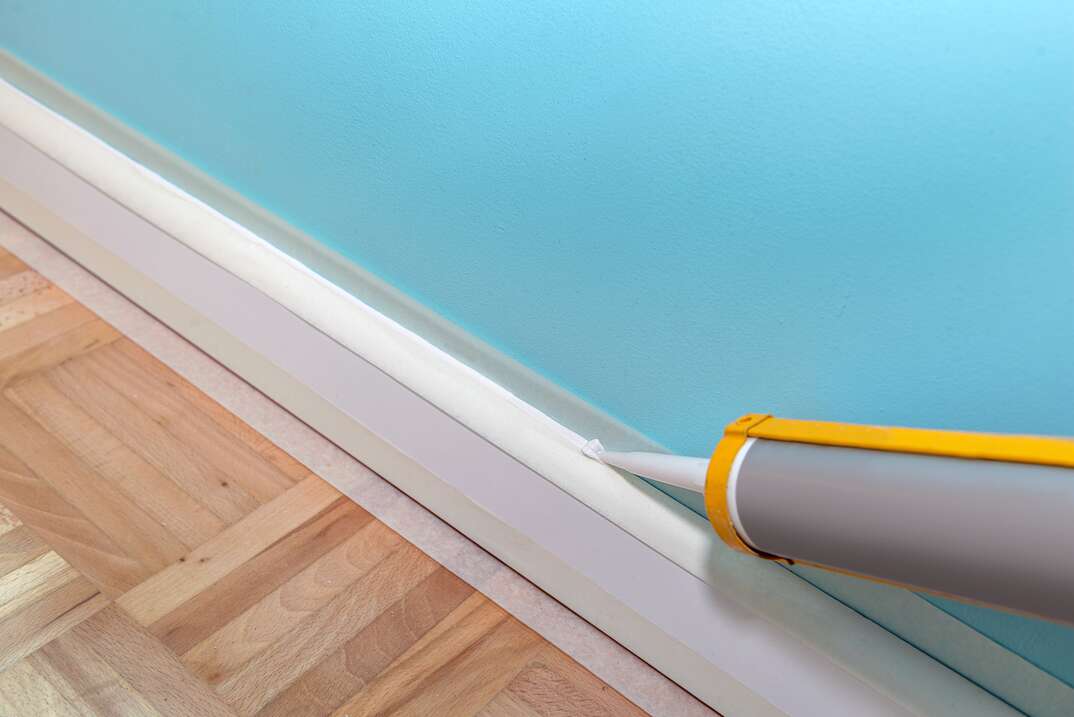Hardwood Floor Installation Guide

Installing Hardwood Floors at a Glance
- Tools & Materials: Pry bar, floor overlay, 3/4-inch spacers, power drill, flooring nails, shoe molding, transition strips, table saw, wood filler, putty knife
- Step 1: Prepare subfloor
- Step 2: Mark layout line
- Step 3: Lay first row
- Step 4: Install other rows
- Step 5: Install baseboards
- Step 6: Fill holes
Many people are intimidated by the work involved in hardwood floor installation, but it's actually an achievable project — as long as you have the right tools and you follow an installation guide. Adding beautiful hardwood floors to your home doesn't just improve its appearance; it also helps to warm up chilly rooms and can even boost the resale value.
This May Also Interest You: How Much Does It Cost to Install Hardwood Floors?
Ready to get started? Here are the step-by-step instructions for how to install hardwood floors, along with answers to some questions you may have during the process.
Can I Install Hardwood Floors Myself?
Before you start, read these instructions a few times so that you know what you're doing and make sure that you have all the tools and materials you need.
Hardwood floor installation is a major project that will take at least a day to complete, although it could take several days if your room is especially large or you want to install a new floor in several rooms. If you don't have the time or DIY skills, you may be better off hiring a contractor to do the job for you.
Is It Easy to Install Hardwood Floors?
While hardwood floor installation is achievable for most DIYers, it's more complicated than many other floor types. Installing solid hardwood boards is one of the more difficult ways to DIY a wood floor, so it's important to read the step-by-step instructions thoroughly before you start.
It's easier to lay a hardwood floor if you have straight walls and no fireplaces or other obstacles to work around. If you have diagonal walls or want to follow an intricate wood floor layout pattern, the job will be more challenging and time-consuming.
If you're not confident about your DIY skills or don't want to drill and nail your floor down, a simpler alternative is a click-lock wood floor. These boards are made from engineered wood and connect together using a simple clicking method. Some click-lock floors simply float above the subfloor without any nails or adhesive, but others need to be glued down.
Of course, you could always hire a contractor to lay a solid wood floor for you, but this will significantly increase the project cost.
Step-by-Step Guide to Hardwood Floor Installation
Before you start, you'll need to purchase enough hardwood boards to cover your entire room, plus an extra 5% to 10% trimming allowance. Allow the boards to acclimate to the temperature and humidity in the room where you intend to lay them for at least five days beforehand.
There are several installation methods for hardwood floors, but the following guide uses the nail-down technique for solid boards.

Tools and Materials
You'll need the following equipment:
- Pry bar
- Floor underlay
- 3/4-inch spacers
- Power drill
- Flooring nails
- Shoe molding
- Transition strips
- Table saw
- Wood filler
- Putty knife
Step 1: Prepare the Subfloor
You should install wood floor panels on a level surface, so start by sanding down any raised areas and filling in any depressions. Pry the baseboards off using a pry bar and put them somewhere safe if you intend to reuse them.
Next, cover the entire floor in an underlay to dampen noise from the floor and prevent moisture from building up underneath. A material like asphalt felt or silicone is ideal.
Finally, unpack the board boxes and lay the panels on the subfloor in the order you intend to install them. The boards in each box will have a relatively uniform color, but each box could be slightly different, so it's a good idea to mix up the boxes to achieve a more natural appearance and avoid solid color stripes in different areas.
Step 2: Mark the Layout Line
Start hardwood floor installation from the longest, straightest wall in the room. At each end, measure the width of one board plus an extra 1/2 inch to allow for natural expansion. Place a mark so that you know where to start from.
Step 3: Lay the First Row
Line the first board along your layout line, and add a 3/4-inch spacer between the board and the wall. The tongue should face away from the wall.
Using a power drill, make holes every 6 inches along the edge of the board parallel to the guiding wall, maintaining an even distance of roughly 1/2 to 1 inch from the edge. Hammer flooring nails through the holes.
Next, drill 45-degree holes along the board's tongue, deferring to the manufacturer's instructions for the distance between each hole. Then, countersink the nails.
You can now lay the second board of the row, slotting the groove into the tongue to get a secure, seamless fit. Use flooring nails to secure the second board to the floor. Continue laying the rest of the row in the same way. You'll need to cut the final board with a 3/4-inch allowance at the edge of the room for expansion.
More Related Articles:
- How to Repair and Prevent Sun Fading on Your Hardwood Floors
- Don’t Get Cold Feet! Everything You Need to Know About Radiant Floor Heating
- How to Fix Scratches on Hardwood Floors
- How Much Does It Cost to Refinish Hardwood Floors?
- How to Refinish Hardwood Floors: 9 Steps, Start to Finish
Step 4: Lay the Rest of the Floor
Next, install the subsequent rows, staggering the boards by at least 6 inches. Nail each board to its neighbor using the drilled holes on the tongue. Remember to use a spacer at the start of each row and leave a 3/4-inch at the end of each row for expansion.
You'll probably need to cut the wood floor panels by width to lay the final row, once again leaving a 3/4-inch gap so that the boards have room to expand.

Step 5: Install the Baseboards and Shoe Molding
Put the baseboards back along the bottom perimeter of the wall so that they're flush with the floor, securing them in place with nails. Lay the shoe molding around the edge of the baseboards and nail it down. You should attach it to the baseboard instead of nailing it into the hardwood panels.
If you can still see the edge of the boards where you left an expansion gap, you'll need to cover them. Lay transition strips along the perimeter and drill screws into the predrilled holes for a seamless finish.
Step 6: Fill Any Holes
Even if you work very carefully, you'll probably end up with a few gaps in your wood flooring. Fortunately, you can fill these gaps with wood filler so they're virtually undetectable.
Clean and dry the floor before you start filling in the gaps. Ensure that you choose a wood filler that's as closely matched to the floor's color as possible and suitable for the wood species. Gently push the filler into the gap using a putty knife. It will contract as it dries, so apply a little and then add more gradually as it dries out, smoothing the surface with the knife after the final application.
Leave the filler to dry out completely, following the suggested timeframe in the manufacturer's instructions. If there are any uneven areas, sand them gently until you achieve a smooth surface. Keep the filler in case you need to refinish the floor and fill new gaps once it's expanded.
How Much Does It Cost to Install 1,000 Square Feet of Hardwood Floors?
The price depends on various factors, including the type of wood you use and the going rates for contractors in your area. If you have your floor fitted for you, the price per 1,000 square feet ranges from $2,300 to $6,200, with a national average of $4,200, according to HomeGuide. Around 25% to 50% of this pays for labor. So you can significantly reduce the project cost by installing a hardwood floor yourself, especially if you already have some of the equipment. Keep in mind that you'll also need to consider the costs of refinishing the floor occasionally to keep it looking like new.


